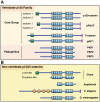The molecular evolution of the p120-catenin subfamily and its functional associations
- PMID: 21209830
- PMCID: PMC3013132
- DOI: 10.1371/journal.pone.0015747
The molecular evolution of the p120-catenin subfamily and its functional associations
Abstract
Background: p120-catenin (p120) is the prototypical member of a subclass of armadillo-related proteins that includes δ-catenin/NPRAP, ARVCF, p0071, and the more distantly related plakophilins 1-3. In vertebrates, p120 is essential in regulating surface expression and stability of all classical cadherins, and directly interacts with Kaiso, a BTB/ZF family transcription factor.
Methodology/principal findings: To clarify functional relationships between these proteins and how they relate to the classical cadherins, we have examined the proteomes of 14 diverse vertebrate and metazoan species. The data reveal a single ancient δ-catenin-like p120 family member present in the earliest metazoans and conserved throughout metazoan evolution. This single p120 family protein is present in all protostomes, and in certain early-branching chordate lineages. Phylogenetic analyses suggest that gene duplication and functional diversification into "p120-like" and "δ-catenin-like" proteins occurred in the urochordate-vertebrate ancestor. Additional gene duplications during early vertebrate evolution gave rise to the seven vertebrate p120 family members. Kaiso family members (i.e., Kaiso, ZBTB38 and ZBTB4) are found only in vertebrates, their origin following that of the p120-like gene lineage and coinciding with the evolution of vertebrate-specific mechanisms of epigenetic gene regulation by CpG island methylation.
Conclusions/significance: The p120 protein family evolved from a common δ-catenin-like ancestor present in all metazoans. Through several rounds of gene duplication and diversification, however, p120 evolved in vertebrates into an essential, ubiquitously expressed protein, whereas loss of the more selectively expressed δ-catenin, p0071 and ARVCF are tolerated in most species. Together with phylogenetic studies of the vertebrate cadherins, our data suggest that the p120-like and δ-catenin-like genes co-evolved separately with non-neural (E- and P-cadherin) and neural (N- and R-cadherin) cadherin lineages, respectively. The expansion of p120 relative to δ-catenin during vertebrate evolution may reflect the pivotal and largely disproportionate role of the non-neural cadherins with respect to evolution of the wide range of somatic morphology present in vertebrates today.
Conflict of interest statement
Figures




Similar articles
-
The evolutionary history of the catenin gene family during metazoan evolution.BMC Evol Biol. 2011 Jul 8;11:198. doi: 10.1186/1471-2148-11-198. BMC Evol Biol. 2011. PMID: 21740572 Free PMC article.
-
The p120 family of cell adhesion molecules.Eur J Cell Biol. 2005 Mar;84(2-3):205-14. doi: 10.1016/j.ejcb.2004.12.016. Eur J Cell Biol. 2005. PMID: 15819401 Review.
-
DIPA-family coiled-coils bind conserved isoform-specific head domain of p120-catenin family: potential roles in hydrocephalus and heterotopia.Mol Biol Cell. 2014 Sep 1;25(17):2592-603. doi: 10.1091/mbc.E13-08-0492. Epub 2014 Jul 9. Mol Biol Cell. 2014. PMID: 25009281 Free PMC article.
-
p120 Catenin is required for normal tubulogenesis but not epithelial integrity in developing mouse pancreas.Dev Biol. 2015 Mar 1;399(1):41-53. doi: 10.1016/j.ydbio.2014.12.010. Epub 2014 Dec 16. Dev Biol. 2015. PMID: 25523391 Free PMC article.
-
Evolution and diversity of cadherins and catenins.Exp Cell Res. 2017 Sep 1;358(1):3-9. doi: 10.1016/j.yexcr.2017.03.001. Epub 2017 Mar 6. Exp Cell Res. 2017. PMID: 28268172 Review.
Cited by
-
p120 catenin is required for the stress response in Drosophila.PLoS One. 2013 Dec 12;8(12):e83942. doi: 10.1371/journal.pone.0083942. eCollection 2013. PLoS One. 2013. PMID: 24349561 Free PMC article.
-
Origin and Evolution of the Multifaceted Adherens Junction Component Plekha7.Front Cell Dev Biol. 2022 Mar 23;10:856975. doi: 10.3389/fcell.2022.856975. eCollection 2022. Front Cell Dev Biol. 2022. PMID: 35399503 Free PMC article.
-
Identification of novel NPRAP/δ-catenin-interacting proteins and the direct association of NPRAP with dynamin 2.PLoS One. 2011;6(10):e25379. doi: 10.1371/journal.pone.0025379. Epub 2011 Oct 14. PLoS One. 2011. PMID: 22022388 Free PMC article.
-
Nuclear ARVCF protein binds splicing factors and contributes to the regulation of alternative splicing.J Biol Chem. 2014 May 2;289(18):12421-34. doi: 10.1074/jbc.M113.530717. Epub 2014 Mar 18. J Biol Chem. 2014. PMID: 24644279 Free PMC article.
-
Direct RNA sequencing mediated identification of mRNA localized in protrusions of human MDA-MB-231 metastatic breast cancer cells.J Mol Signal. 2013 Sep 1;8(1):9. doi: 10.1186/1750-2187-8-9. J Mol Signal. 2013. PMID: 24004954 Free PMC article.
References
-
- Schneider SQ, Finnerty JR, Martindale MQ. Protein evolution: structure-function relationships of the oncogene beta-catenin in the evolution of multicellular animals. J Exp Zool B Mol Dev Evol. 2003;295:25–44. - PubMed
-
- Gallin WJ. Evolution of the “classical” cadherin family of cell adhesion molecules in vertebrates. Mol Biol Evol. 1998;15:1099–1107. - PubMed
-
- Hulpiau P, van Roy F. Molecular evolution of the cadherin superfamily. Int J Biochem Cell Biol. 2009;41:349–369. - PubMed
Publication types
MeSH terms
Substances
Grants and funding
LinkOut - more resources
Full Text Sources
Molecular Biology Databases
Miscellaneous

